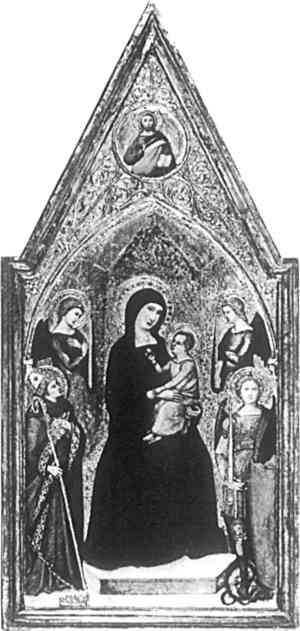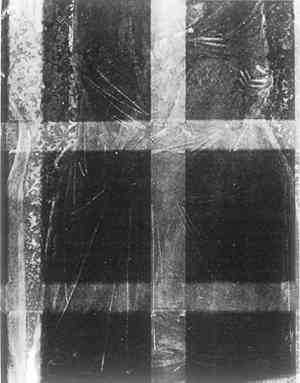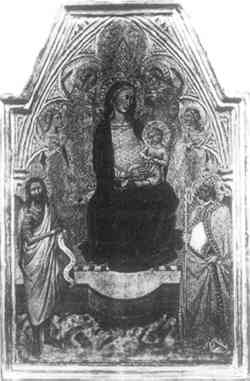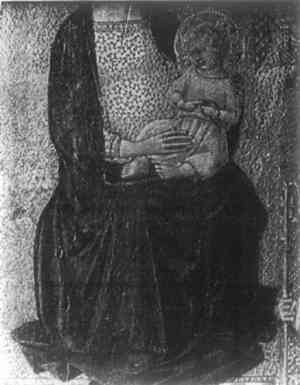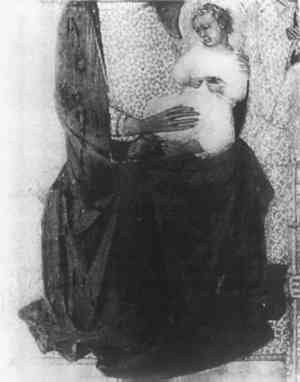THREE METHODS OF MODELLING THE VIRGIN'S MANTLE IN EARLY ITALIAN PAINTINGNorman E. Muller
ABSTRACT—Three methods of modelling the Virgin's blue mantle in early Italian painting are discussed. The first is modelling in three values, mentioned by Cennino Cennini in Chapter CXLV of his treatise; the second is the two-value system, noted in Cennino's Chapter CXLVI; and the third is a schematic two-value method of indicating light and shade that was not mentioned by Cennino, but which appears in four late fourteenth century Sienese paintings. The author suggests that the latter technique originated in Siena and was a modification of earlier methods of depicting folds, such as are found on late thirteenth century painting. 1 INTRODUCTIONIn the late Medieval and early Renaissance periods there were two common methods of painting the Virgin's mantle, both of which were described by Cennino Cennini in his Il Libro dell'Arte. There was also a third method, much rarer than the other two, that has been found by the present writer in only four paintings. Distinct from the two more common techniques, it is nevertheless related in an abstract fashion to one of them, and, furthermore, borrows from a tradition practiced in the late thirteenth century. It should be viewed, therefore, as a logical outgrowth of practices present in the thirteenth and fourteenth centuries. Linked as it is to previous traditions, the first two techniques will be briefly examined before discussing the more rarely practiced one. 2 MODELLING IN THREE VALUESAmerican conservators are undoubtedly most acquainted with the technique of modelling up to the highlights with three values of blue as described by Cennino in Chapter CXLV of his treatise.2 Pure blue, generally ultramarine but occasionally azurite, was laid in for the shadows over the underdrawing on the gesso. A lighter value of blue, having lead white as its major component, was juxtaposed next to the pure blue and carefully shaded into it so that no sharp division would be perceived by the viewer. Finally, white or pale blue was applied for the highlights.3 Artists varied in their handling of this method. Some, such as Giotto and Pietro Lorenzetti, for example,4 made a special effort to carefully blend the three values of blue; whereas others, such as the close follower of Lorenzo Monaco who painted the Virgin Annunciate in the Norton Simon Museum of Art as shown in Figure 1, 5 were less painstaking in their treatment. Although this particular technique of modelling was practiced by most Italian artists, it was no more frequently used than the next one to be considered.
3 THE TWO-VALUE SYSTEM OF MODELLINGEqually as common as the technique mentioned above was the abbreviated method Cennino carefully described for fresco technique in Chapter LXXXIII and which he briefly noted in Chapter CXLVI as an alternative method of shading in three values. As with the three-value system of modelling, the artist first prepared a carefully shaded drawing on the gesso. Then with a stylus he incised lines in the gesso along the major folds of the drapery. This technique, similar in fashion to the cartoon incisions found on some fifteenth century panel paintings,6 was used to preserve the main outline of the underdrawing from the obscuring effects that followed.7 At this point there were certain variations in the system. In a small panel by Meo da Siena in the Worcester Art Museum, and in the “Benson” Madonna and Child by Lippo Memmi in the National Gallery of Art, Washington, an even layer of dense paint was applied over the gesso before the blue egg tempera paint was brushed on. X-radiographs of these paintings revealed a density to the mantles that could not be explained by the blue pigments being used.8 Perhaps the artists brushed on a grey or red wash over the gesso, the primary constituent being lead white, simulating the technique that is found in many Trecento fresco paintings. Beneath the azurite blues applied a secco on Simone Martini's fresco cycle in the St. Martin Chapel of San Francesco at Assisi, grey and red washes are found where the blue has flaked off. While no one has attempted to explain the function of these washes9, they evidently served a purpose since they are restricted to the blues. The most reasonable explanation is that the translucent blues, azurite and ultramarine, served much like the colored grounds in later Venetian painting in that some light would be transmitted through the crystal grains and reflect off the ground. The resultant wave length of light as perceived by the eye would be registered as alterations in hue. Consequently, the reddish ground would cause a slight shift to the lower end of the light spectrum, whereas the grey would, one presumes, result in a deeper saturation of the blue. A modification of this method was practiced by Luca di Tomm�, a late fourteenth century Sienese artist who, in a painting of the Madonna and Child with Saints Louis of Toulouse and Michael in the Los Angeles County Museum of Art, as shown in Figure 2, modelled his folds with a lead white based grey paint applied over the underdrawing. Some of this paint collected in the incised lines inscribed in the gesso, which accounts for the density of these lines on the X-radiograph of the painting, as shown in Figure 3.10 From a study of numerous X-radiographs of early Italian paintings, not all artists practiced these two techniques, however.11
A flat wash of pure ultramarine blue or azurite egg tempera paint was next brushed over the entire area reserved for the mantle. As strange as this may seem, the carefully executed underdrawing was not purposeless, for the drawing enabled the artist to arrange the folds of the mantle in a way that would accurately reveal the structure of the body underneath. Moreover, the artist probably had a preliminary sketch at hand, which he could use as a guide when the time came to model the folds.12 The shallow depressions of the incisions remained after these steps were completed, and the artist then laid in the shadows with a dark paint consisting of a mixture of black and indigo,13 using the incisions as a guide. Most paintings in which this two-value system was practiced have suffered from abrasion of the surface layers, as seen in Luca di Tomme's painting, as shown in Figure 2, or a combination of abrasion and darkening of the azurite blue layer. Where azurite was used, accumulated darkened varnish in the voids surrounding the mineral grains have contributed to the flat, dark blue-blacks conservators often encounter when treating paintings from the Trecento and Quattrocento. Not all paintings are so disfigured, however. Examples in which the salient details have been preserved from harsh abrasion in the past, are a beautifully preserved Trinity by Nardo di Cione in the Accademia, Florence,14 and a Crucifixion by the same artist in the Uffizi, Florence.15 A careful study of these paintings is worth more than several readings of Cennino's treatise. 4 NICCOL� DI BUONACCORSO'S METHOD OF MODELLINGA most unusual technique of modelling is found on a central panel of a triptych in the Museum of Fine Arts, Boston, attributed to Niccol� di Buonaccorso, a late fourteenth century Sienese artist, as shown in Figure 4. Executed in a two-value technique similar to that described previously, it is nevertheless completely different.
We can immediately perceive this distinction in a raking light photograph of the Virgin's mantle, as shown in Figure 5. A dark shade of blue, simulating the shadows, is raised above
An infrared photograph was taken of the Virgin's mantle, and the result, as shown in Figure 6, revealed a high infrared reflectance of the dark blue and a high absorption of the infrared rays by the greenish-blue areas. These characteristics, which were supported by photographic evidence obtained by color infrared photography,17 suggested the presence of ultramarine and azurite blue, respectively.18
Of the hundreds of Tuscan fourteenth century panel paintings that have been studied by the author in American and European collections, only three other paintings are known where this technique appears. One is Buonaccorso's Madonna of Humility in the Timken Art Gallery, San Diego, where the Virgin Annunciate's mantle in the pinnacle of the right wing was painted in this fashion. Another is Buonaccorso's Pieta in the Lehman Collection, New York; and the third example is Niccol� di Ser Sozzo Tegliacci's Madonna and Child in the Uffizi, Florence.19 Tegliacci, like Buonaccorso, was a Sienese painter, and his Uffizi panel originally came from the church of Sant'Antonio in Bosco in Poggibonsi, a small town close to Siena. With the exception of the Lehman painting, which was studied only with a hand lens, the other two paintings were photographed with color infrared film, which gave results similar to the Boston panel. The identification of the technique of modelling on the Tegliacci panel establishes an early date for the technique and, furthermore, connects it with the Lorenzetti workshop. Tegliacci's painting was probably executed in the early 1350's, shortly after the death of the Lorenzetti brothers in the plague of 1348. At the time of the dissolution of the shop, Tegliacci acquired approximately eight of Ambrogio's punching tools and one of Pietro's,20 which he used in fashioning his own halo designs. Two of these distinctive motif impressions of Ambrogio's appear in the Uffizi painting. To this it should be mentioned that Tegliacci also employed ritagliare or “marking out” in his paintings.21 This was a technique of re-establishing the original outline of the figure after the gold leaf had been laid by brushing a line of white lead paint over the superfluous leaf that had lapped over the incised line. The density of this outlining is clearly visible on X-radiographs. Research by the author has shown that the technique was restricted in Siena to the workshop of Pietro Lorenzetti, whereupon it was adopted by his students. Tegliacci, therefore, can be counted as a member of that workshop in his early years, and later transferred to the shop operated by Ambrogio. A more detailed study of this interesting technique is in preparation by the author. Buonaccorso's early artistic career is more obscure than Tegliacci's. Only a few documents from the 1370's mention him, and he signed only two works, one of which (the Marriage of the Virgin in the National Gallery, London) was completed in 1387, the year before his death. Yet despite the paucity of information surrounding this artist, scholars are in general agreement that his known works reveal a stylistic indebtedness to Ambrogio Lorenzetti. To this it can be added that his adoption of the unique method of modelling the Virgin's mantle, as found in three of his works, also connects him with Tegliacci, and from him to Ambrogio Lorenzetti. Buonaccorso's extensive use of sgraffito,22 which originally was introduced by Simone Martini in his Annunciation of 1333, was a dominant mode of Sienese design in the 1350's. The Maestro d'Ovile was perhaps the leading practitioner of this rich technique, and his adoption of it influenced a host of minor Sienese masters, among whom one can list Tegliacci, Bartolo di Fredi, Paolo di Giovanni Fei, Jacopo di Mino Pellicciaio and Niccol� di Buonaccorso. Furthermore, in Buonaccorso's small Crucifixion in Perugia, the border punchwork bears a motif that is strikingly similar to a punch While the discovery of a rare technique is in itself interesting, of particular fascination is the manner by which Buonaccorso indicated light and shade. This abbreviated system, which is the exact opposite of Cennino's technique of modelling in three values, in that here the artist worked up to the darks (it is similar in this respect to the second technique), compares with modelling techniques found in late thirteenth century painting. In this period, highlights were often rendered schematically by applying gold leaf in a striated fashion over the blue mantle. We find this technique in Duccio's Ruccellai Maesta of the late 1280's and Coppo di Marcovaldo's Madonna in Santa Maria dei Servi, Orvieto, which was executed a decade or two earlier. Leading Sienese artists in the following century were often looking back in time for modes of design and techniques that they could modify and incorporate in their own painting. Ambrogio Lorenzetti was one of the most inventive of these artists, and his Vico l'Abate Madonna of 1319, with its severely frontal placement, is based on earlier, Dugento representations of the Virgin. And the Uffizi Bari panels, which were once joined to a now lost central panel probably depicting Saint Nicholas of Bari, formed an altarpiece similar in design to Dugento rectangular dossals. An artist of the caliber of Ambrogio was continually looking to the past to enrich his own art, and this tradition he passed on to his students and followers, such as Tegliacci and Buonaccorso, who in their own manner continued to modify older technical methods. REFERENCESConservator, Worcester Art Museum, 55 Salisbury Street, Worcester, MA 01608. CenninoCennini, The Craftsman's Handbook, Daniel V.ThompsonJr.ed. and trans., New York, Dover Publications, 1954, p. 91. The chapter number is found in the edition of Carlo and Gaetano Milanesi (II Libro dell'arte o trattato della pittura, di Cennino Cennini da Colle Valdelsa; di nuovo pubblicato con molte correzioni e coll' aggiunta di piu capitoli tratti dai codici fiorentini, Florence, 1859) which was based on an earlier translation of Giuseppe Tambroni (Di Cennino Cennini tratto della pittura, messo in luce la prima volta con annotazioni, Rome, 1821). The linearity characteristic of some artist's work, Lorenzo Monaco for example, was achieved by a sharper contrast between highlight and shadow. Lorenzo nearly always used a pure white highlight, whereas Pietro Lorenzetti, who was influenced by the more sculptural techniques of modelling prevalent in Florentine painting, allowed a more gradual transition between shadow and highlight. His highlights were usually a pale blue (Pope's HLt: See Arthur Pope, The Language of Drawing and Painting, Cambridge, 1949, pp. 7–8). By modifying the value transition in this way, he obtained the fuzzy quality of modelling that is found throughout his entire artistic output. Giotto's Maesta in the Uffizi is a good example as is Pietro Lorenzetti's Madonna and Child with Eight Angels, dated 1340, also in the same Gallery.
There is a sharper division between the highlights and middle tones than one can perceive on paintings definately attributable to the master. A particularly striking comparison may be made between the Virgin Annunciate in Lorenzo's signed Coronation of the Virgin in the Uffizi, and the Simon painting. The Uffizi polyptych is dated 1414 and the Simon Virgin Annunciate was once a pinnacle over the Coronation in the National Gallery, London, which has been dated shortly after the Uffizi painting. For a discussion of these two works, see Martin Davies, The Earlier Italian Schools, London, The National Gallery, 1961, pp. 306–309; and Georg Pudelko, “The Stylistic Development of Lorenzo Monaco—I,” The Interesting examples are Baldovinetti's Annunciation, Florence, Uffizi, and Master of the Crivellesque Polyptychs, Polyptych: Madonna Adoring the Child in her Lap; SS. Bonaventura, Michael, Francis and Bernardino of Siena, Formerly Harewood House, Earl of Harewood. Baldovinetti's painting is dated shortly before 1460 and the Crivellesque Polyptychs Master's to the late 15th century. Both paintings are illustrated in Berenson's Italian Pictures of the Renaissance; the former in Vol. II of the Florentine School, London, 1963, Pl. 795; and the latter in Vol. II of the Central Italian and North Italian Schools, New York, 1968, Pl. 965. A discussion of Byzantine fresco incisions may be found in D. C. Winfield's “Middle and Later Byzantine Wall Painting Methods. A Comparative Study,” Dumbarton Oaks Papers, 22, 1968, pp. 61–139. Many artists worked in both fresco and panel painting, and ideas that were developed in fresco were frequently transmitted to panel painting. An example of this is Simone Martini's punchwork decoration that appears in his frescoed Maesta of 1315 and was adopted by him for his Naples panel of 1317. Neither azurite nor ultramarine blue is strongly opaque to X-rays. For a discussion of their properties, see JoycePlesters, “Ultramarine Blue, Natural and Artificial,” Studies in Conservation, 11, 1966, p. 72; and R. J.Gettens and E. W.Fitzhugh, “Azurite and Blue Verditer,” Studies in Conservation, 11, 1966, p. 57. While Tintori and Meiss (The Painting of the Life of St. Francis in Assisi, Norton Paperback N393, 1967, p. 62 and 171) frequently make references to the grey or red washes underlying the azurite blues in the Assisi frescoes, no explanation was given for them. The X-radiograph was exposed for 90 secs, at 5 MA and 40 KV. A sample of paint was extracted from one of the incised lines, mounted in casting resin and ground down to cross-section. A thin layer of grey paint (white and black particles) had been brushed directly over the gesso, and some of it collected in the incised lines. See my “Observations on the Painting Technique of Luca di Tomm�,” Los Angeles County Museum of Art Bulletin, 19, 1973, pp. 12–21. I have observed instances in which the artist executed the mantle in a two-value system without the aid of incised lines. The probable use of drawings in Early Italian Painting was discussed in the article by Ben B.Johnson and Norman E.Muller, “A Study of Technical Aspects and Stylistic Sources of The Martyrdom of Pope Caius by Lorenzo Monaco,” Archivero I, Santa Barbara, California, 1973, pp. 23–56. CenninoCennini, op. cit., Chapter LXXXIII, p. 55. This painting is in exceptionally fine condition. A diagonal scrape mark is found through the robe of St. John and the surface is covered with a thin, uneven yellowish film. The ultramarine blue mantle of God the Father preserves the blue black shadows that Cennino recommended (see n. 12 above), but no incised lines have been observed in it. The Crucifixion, like the Trinity, is in superb condition for a painting of its age. The gold leaf is clean with no evidence of wear. Unfortunately, the figures seem to be covered with a grey layer (darkened egg white?) that makes them difficult to read. A cleaning was attempted in the past but was abandoned as being too risky. Still, the clarity and crispness of the surface detail is there for all to study. Azurite blue, when mixed with the yoke of egg, tends to turn slightly green. Because of this, it was not as frequently modelled in the same way as ultramarine, which was discussed in the first section of this article. Ultramarine blue appears red on a color infrared transparency owing to the sensitizing of the cyan or infrared sensitive layer in the emulsion. Azurite appears blue or blue black. For a more detailed discussion of this film's properties, see CharlesOlin and ThomasCarter's “Infrared Color Photography of Painting Materials,” in: Papers of the American Institute for Conservation (A. I. C.), Los Angeles, 1971, pp. 83–87. The final arbiter in this case should of course be optical or chemical analysis of the mineral grains. In view of the raised quality of the ultramarine blue, this paint should also be tested for the type of medium present.
A full discussion of this painting is found in Luisa Marcucci's I Dipinti Toscani del Secolo XIV, Rome, 1965, pp. 168–169. ErlingSkaug, “Notes on the Chronology of Ambrogio Lorenzetti and a New Painting from His Shop,” Mitteilungen des Kunsthistorischen Institutes in Florenz, 20, 1976, p. 314 and n. 43. Pietro's punch mark is no. 29 in Table II, p. 330. Cennino, op. cit., Chapter CXL, pp. 85–86. Sgraffito was a method of depicting gold embroidered drapery by completely covering gold leaf with egg tempera paint and then scraping away patterns of the paint down to the gold leaf. See. Cennino, op. cit., pp. 86–88.
 Section Index Section Index |

